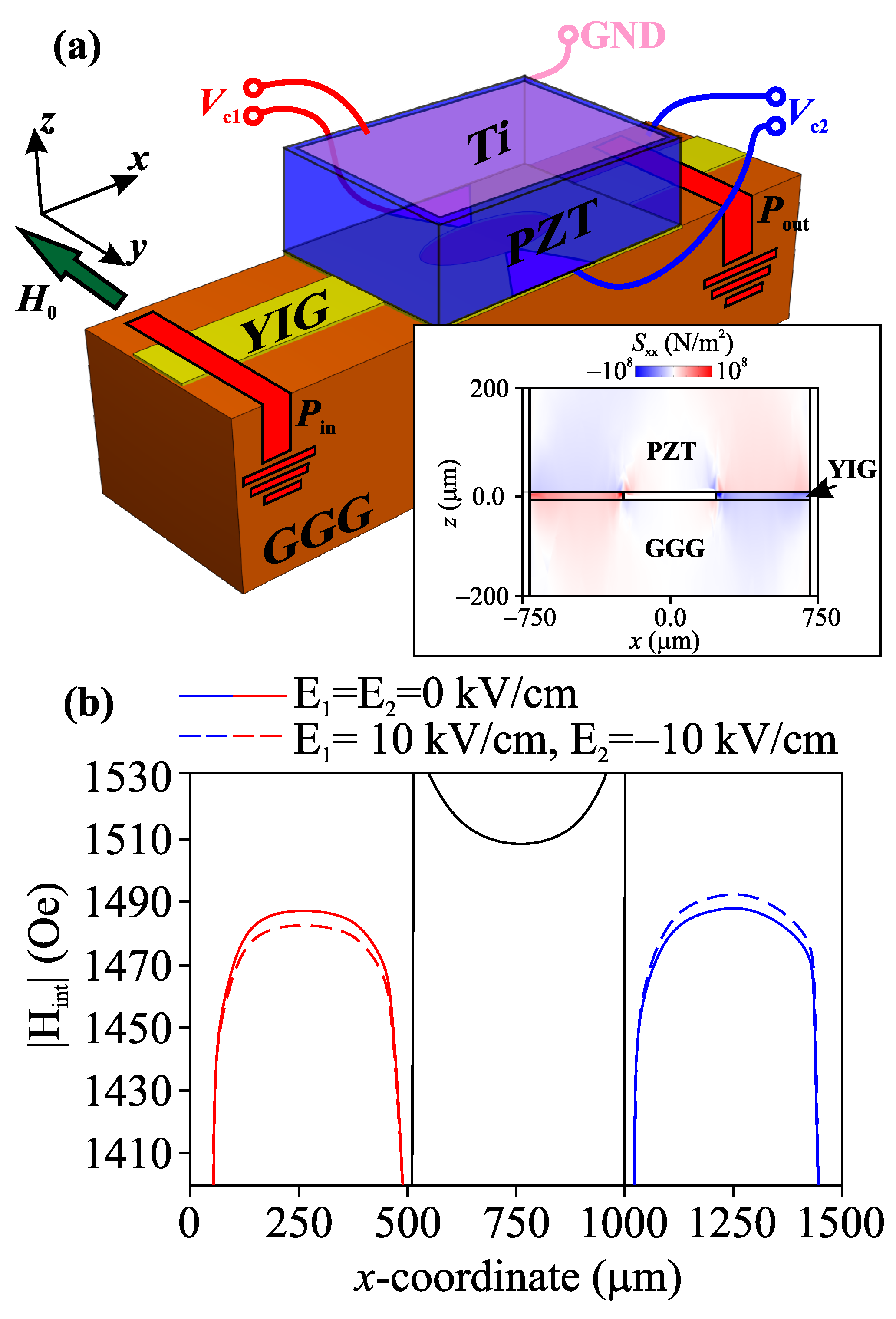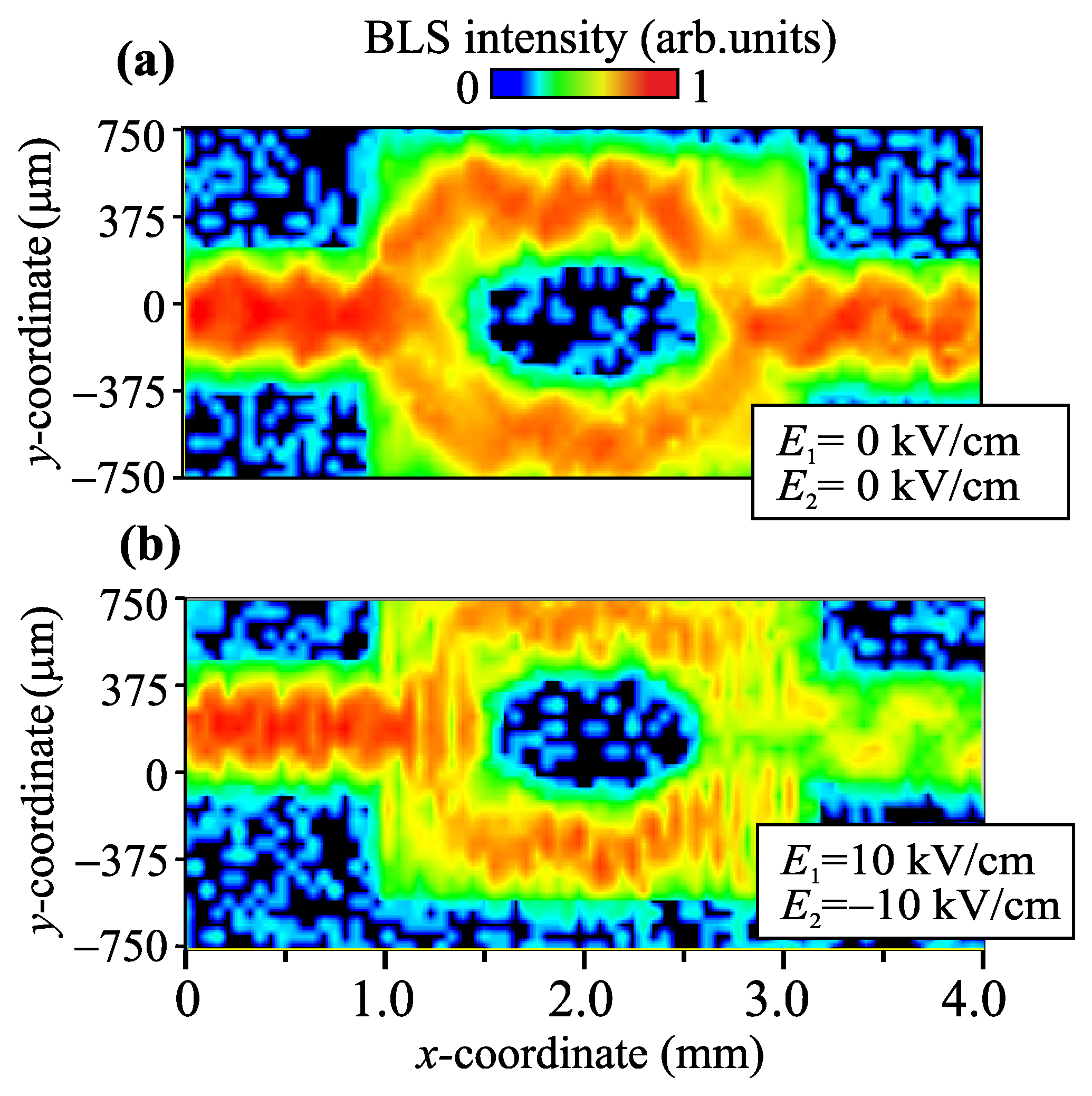Strain-Tuned Spin-Wave Interference in Micro- and Nanoscale Magnonic Interferometers
Abstract
:1. Introduction
2. Structure Fabrication
3. Numerical Calculations
4. Experimental Observation of Voltage-Controlled Manipulation of Spin-Wave Amplitude
5. Conclusions
Author Contributions
Funding
Data Availability Statement
Acknowledgments
Conflicts of Interest
Sample Availability
References
- Wang, Q.; Kewenig, M.; Schneider, M.; Verba, R.; Kohl, F.; Heinz, B.; Geilen, M.; Mohseni, M.; Lägel, B.; Ciubotaru, F.; et al. A magnonic directional coupler for integrated magnonic half-adders. Nat. Electron. 2020, 3, 765–774. [Google Scholar] [CrossRef]
- Wang, Q.; Pirro, P.; Verba, R.; Slavin, A.; Hillebrands, B.; Chumak, A.V. Reconfigurable nanoscale spin-wave directional coupler. Sci. Adv. 2018, 4, e1701517. [Google Scholar] [CrossRef] [PubMed] [Green Version]
- Barman, A.; Gubbiotti, G.; Ladak, S.; Adeyeye, A.O.; Krawczyk, M.; Gräfe, J.; Adelmann, C.; Cotofana, S.; Naeemi, A.; Vasyuchka, V.I.; et al. The 2021 Magnonics Roadmap. J. Phys. Condens. Matter 2021, 33, 413001. [Google Scholar] [CrossRef] [PubMed]
- Kruglyak, V.V.; Demokritov, S.O.; Grundler, D. Magnonics. J. Phys. D Appl. Phys. 2010, 43, 264001. [Google Scholar] [CrossRef]
- Mouadili, A.; Boudouti, E.H.E.; Akjouj, A.; Al-Wahsh, H.; Djafari-Rouhani, B.; Dobrzynski, L. Y-shaped magnonic demultiplexer using induced transparency resonances. AIP Adv. 2019, 9, 035011. [Google Scholar] [CrossRef] [Green Version]
- Heussner, F.; Talmelli, G.; Geilen, M.; Heinz, B.; Brächer, T.; Meyer, T.; Ciubotaru, F.; Adelmann, C.; Yamamoto, K.; Serga, A.A.; et al. Experimental Realization of a Passive Gigahertz Frequency-Division Demultiplexer for Magnonic Logic Networks. Phys. Status Solidi Rapid Res. Lett. 2020, 14, 1900695. [Google Scholar] [CrossRef] [Green Version]
- Sadovnikov, A.V.; Davies, S.; Grishin, S.V.; Kruglyak, V.V.; Romanenko, D.V.; Sharaevskii, Y.P.; Nikitov, S.A. Magnonic beam splitter: The building block of parallel magnonic circuitry. Appl. Phys. Lett. 2015, 106, 192406. [Google Scholar] [CrossRef]
- Heussner, F.; Serga, A.A.; Brächer, T.; Hillebrands, B.; Pirro, P. A switchable spin-wave signal splitter for magnonic networks. Appl. Phys. Lett. 2017, 111, 122401. [Google Scholar] [CrossRef]
- Wang, X.; Zhang, H.; Wang, X. Topological Magnonics: A Paradigm for Spin-Wave Manipulation and Device Design. Phys. Rev. Appl. 2018, 9, 024029. [Google Scholar] [CrossRef]
- Hertel, R.; Wulfhekel, W.; Kirschner, J. Domain-Wall Induced Phase Shifts in Spin Waves. Phys. Rev. Lett. 2004, 93, 257202. [Google Scholar] [CrossRef] [Green Version]
- Chumak, A.V.; Serga, A.A.; Hillebrands, B. Magnon transistor for all-magnon data processing. Nat. Commun. 2014, 5, 4700. [Google Scholar] [CrossRef] [PubMed] [Green Version]
- Balinskiy, M.; Chiang, H.; Khitun, A. Realization of spin wave switch for data processing. AIP Adv. 2018, 8, 056628. [Google Scholar] [CrossRef]
- Balinskiy, M.; Kargar, F.; Chiang, H.; Balandin, A.A.; Khitun, A.G. Brillouin-Mandelstam spectroscopy of standing spin waves in a ferrite waveguide. AIP Adv. 2018, 8, 056017. [Google Scholar] [CrossRef] [Green Version]
- Khivintsev, Y.; Ranjbar, M.; Gutierrez, D.; Chiang, H.; Kozhevnikov, A.; Filimonov, Y.; Khitun, A. Prime factorization using magnonic holographic devices. J. Appl. Phys. 2016, 120, 123901. [Google Scholar] [CrossRef]
- Kanazawa, N.; Goto, T.; Sekiguchi, K.; Granovsky, A.B.; Ross, C.A.; Takagi, H.; Nakamura, Y.; Uchida, H.; Inoue, M. The role of Snell’s law for a magnonic majority gate. Sci. Rep. 2017, 7, 7898. [Google Scholar] [CrossRef] [PubMed] [Green Version]
- Khitun, A.; Bao, M.; Wang, K.L. Magnonic logic circuits. J. Phys. D Appl. Phys. 2010, 43, 264005. [Google Scholar] [CrossRef]
- Chumak, A.V.; Serga, A.A.; Hillebrands, B. Magnonic crystals for data processing. J. Phys. D Appl. Phys. 2017, 50, 244001. [Google Scholar] [CrossRef]
- Csaba, G.; Papp, A.; Porod, W. Perspectives of using spin waves for computing and signal processing. Phys. Lett. A 2017, 381, 1471–1476. [Google Scholar] [CrossRef] [Green Version]
- Balynsky, M.; Gutierrez, D.; Chiang, H.; Kozhevnikov, A.; Dudko, G.; Filimonov, Y.; Balandin, A.A.; Khitun, A. A Magnetometer Based on a Spin Wave Interferometer. Sci. Rep. 2017, 7, 11539. [Google Scholar] [CrossRef] [Green Version]
- Balynskiy, M.; Chiang, H.; Kozhevnikov, A.; Dudko, G.; Filimonov, Y.; Balandin, A.A.; Khitun, A. Effects of the magnetic field variation on the spin wave interference in a magnetic cross junction. AIP Adv. 2018, 8, 056619. [Google Scholar] [CrossRef]
- Lee, K.S.; Kim, S.K. Conceptual design of spin wave logic gates based on a Mach–Zehnder-type spin wave interferometer for universal logic functions. J. Appl. Phys. 2008, 104, 053909. [Google Scholar] [CrossRef] [Green Version]
- Vasiliev, S.V.; Kruglyak, V.V.; Sokolovskii, M.L.; Kuchko, A.N. Spin wave interferometer employing a local nonuniformity of the effective magnetic field. J. Appl. Phys. 2007, 101, 113919. [Google Scholar] [CrossRef]
- Kanazawa, N.; Goto, T.; Sekiguchi, K.; Granovsky, A.B.; Ross, C.A.; Takagi, H.; Nakamura, Y.; Inoue, M. Demonstration of a robust magnonic spin wave interferometer. Sci. Rep. 2016, 6, 30268. [Google Scholar] [CrossRef] [Green Version]
- Ustinova, I.A.; Nikitin, A.A.; Ustinov, A.B.; Kalinikos, B.A.; Lahderanta, E. Logic gates based on multiferroic microwave interferometers. In Proceedings of the 2017 11th International Workshop on the Electromagnetic Compatibility of Integrated Circuits (EMCCompo), Saint Petersburg, Russia, 4–8 July 2017. [Google Scholar] [CrossRef]
- Rana, B.; Otani, Y. Towards magnonic devices based on voltage-controlled magnetic anisotropy. Commun. Phys. 2019, 2, 1–12. [Google Scholar] [CrossRef] [Green Version]
- Qin, H.; Dreyer, R.; Woltersdorf, G.; Taniyama, T.; van Dijken, S. Electric-Field Control of Propagating Spin Waves by Ferroelectric Domain-Wall Motion in a Multiferroic Heterostructure. Adv. Mater. 2021, 33, 2100646. [Google Scholar] [CrossRef]
- Choudhury, S.; Chaurasiya, A.K.; Mondal, A.K.; Rana, B.; Miura, K.; Takahashi, H.; Otani, Y.; Barman, A. Voltage controlled on-demand magnonic nanochannels. Sci. Adv. 2020, 6, eaba5457. [Google Scholar] [CrossRef]
- Wang, Q.; Chumak, A.V.; Jin, L.; Zhang, H.; Hillebrands, B.; Zhong, Z. Voltage-controlled nanoscale reconfigurable magnonic crystal. Phys. Rev. B 2017, 95, 134433. [Google Scholar] [CrossRef] [Green Version]
- Savchenko, A.; Krivoruchko, V. Electric-field control of nonreciprocity of spin wave excitation in ferromagnetic nanostripes. J. Magn. Magn. Mater. 2019, 474, 9–13. [Google Scholar] [CrossRef]
- Nakata, K.; Kim, S.K.; Klinovaja, J.; Loss, D. Magnonic topological insulators in antiferromagnets. Phys. Rev. B 2017, 96, 224414. [Google Scholar] [CrossRef] [Green Version]
- Krivoruchko, V.; Savchenko, A.; Kruglyak, V. Electric-field control of spin-wave power flow and caustics in thin magnetic films. Phys. Rev. B 2018, 98, 024427. [Google Scholar] [CrossRef] [Green Version]
- Chen, W.; Sigrist, M. Dissipationless multiferroic magnonics. Phys. Rev. Lett. 2015, 114, 157203. [Google Scholar] [CrossRef] [PubMed] [Green Version]
- Sadovnikov, A.V.; Grachev, A.A.; Sheshukova, S.E.; Sharaevskii, Y.P.; Serdobintsev, A.A.; Mitin, D.M.; Nikitov, S.A. Magnon Straintronics: Reconfigurable Spin-Wave Routing in Strain-Controlled Bilateral Magnetic Stripes. Phys. Rev. Lett. 2018, 120, 257203. [Google Scholar] [CrossRef] [PubMed]
- Bukharaev, A.A.; Zvezdin, A.K.; Pyatakov, A.P.; Fetisov, Y.K. Straintronics: A new trend in micro- and nanoelectronics and materials science. Phys. Uspekhi 2018, 61, 1175–1212. [Google Scholar] [CrossRef]
- Bandyopadhyay, S.; Atulasimha, J.; Barman, A. Magnetic straintronics: Manipulating the magnetization of magnetostrictive nanomagnets with strain for energy-efficient applications. Appl. Phys. Rev. 2021, 8, 041323. [Google Scholar] [CrossRef]
- Ciccarelli, C.; Hals, K.M.; Irvine, A.; Novak, V.; Tserkovnyak, Y.; Kurebayashi, H.; Brataas, A.; Ferguson, A. Magnonic charge pumping via spin–orbit coupling. Nat. Nanotechnol. 2015, 10, 50–54. [Google Scholar] [CrossRef]
- Sadovnikov, A.; Beginin, E.; Sheshukova, S.; Sharaevskii, Y.P.; Stognij, A.; Novitski, N.; Sakharov, V.; Khivintsev, Y.V.; Nikitov, S. Route toward semiconductor magnonics: Light-induced spin-wave nonreciprocity in a YIG/GaAs structure. Phys. Rev. B 2019, 99, 054424. [Google Scholar] [CrossRef]
- Brandl, F.; Franke, K.; Lahtinen, T.; Van Dijken, S.; Grundler, D. Spin waves in CoFeB on ferroelectric domains combining spin mechanics and magnonics. Solid State Commun. 2014, 198, 13–17. [Google Scholar] [CrossRef] [Green Version]
- Sadovnikov, A.V.; Grachev, A.A.; Beginin, E.N.; Sheshukova, S.E.; Sharaevskii, Y.P.; Nikitov, S.A. Voltage-Controlled Spin-Wave Coupling in Adjacent Ferromagnetic-Ferroelectric Heterostructures. Phys. Rev. Appl. 2017, 7, 014013. [Google Scholar] [CrossRef]
- Frey, P.; Nikitin, A.A.; Bozhko, D.A.; Bunyaev, S.A.; Kakazei, G.N.; Ustinov, A.B.; Kalinikos, B.A.; Ciubotaru, F.; Chumak, A.V.; Wang, Q.; et al. Reflection-less width-modulated magnonic crystal. Commun. Phys. 2020, 3, 1–7. [Google Scholar] [CrossRef]
- Fetisov, Y.K.; Srinivasan, G. Nonlinear electric field tuning characteristics of yttrium iron garnet—Lead zirconate titanate microwave resonators. Appl. Phys. Lett. 2008, 93, 033508. [Google Scholar] [CrossRef]
- Sando, D.; Agbelele, A.; Rahmedov, D.; Liu, J.; Rovillain, P.; Toulouse, C.; Infante, I.; Pyatakov, A.; Fusil, S.; Jacquet, E.; et al. Crafting the magnonic and spintronic response of BiFeO3 films by epitaxial strain. Nat. Mater. 2013, 12, 641–646. [Google Scholar] [CrossRef] [PubMed]
- Fetisov, Y.K.; Srinivasan, G. Electric field tuning characteristics of a ferrite-piezoelectric microwave resonator. Appl. Phys. Lett. 2006, 88, 143503. [Google Scholar] [CrossRef]
- Sheshukova, S.E.; Beginin, E.N.; Sadovnikov, A.V.; Sharaevsky, Y.P.; Nikitov, S.A. Multimode Propagation of Magnetostatic Waves in a Width-Modulated Yttrium-Iron-Garnet Waveguide. IEEE Magn. Lett. 2014, 5, 1–4. [Google Scholar] [CrossRef]
- Beginin, E.N.; Sadovnikov, A.V.; Sharaevsky, Y.P.; Nikitov, S.A. Spatiotemporal dynamics of magnetostatic and spin waves in a transversely confined ferrite waveguide. Bull. Russ. Acad. Sci. Phys. 2013, 77, 1429–1431. [Google Scholar] [CrossRef]
- Silvester, P.P.; Ferrari, R.L. Finite Elements for Electrical Engineers; Cambridge University Press: Cambridge, UK, 1996. [Google Scholar]
- Vansteenkiste, A.; Leliaert, J.; Dvornik, M.; Helsen, M.; Garcia-Sanchez, F.; Van Waeyenberge, B. The design and verification of MuMax3. AIP Adv. 2014, 4, 107133. [Google Scholar] [CrossRef] [Green Version]
- Srinivasan, G.; Priya, S.; Sun, N. Composite Magneto-electrics Materials, Structures, and Applications; Woodhead: Cambridge, UK, 2015. [Google Scholar]
- Landau, L.D.; Lifschitz, E.M. On the theory of the dispersion of magnetic permeability in ferromagnetic bodies. Phys. Z. Sowjet. 1935, 8, 153. [Google Scholar]
- Sadovnikov, A.V.; Beginin, E.N.; Sheshukova, S.E.; Romanenko, D.V.; Sharaevskii, Y.P.; Nikitov, S.A. Directional multimode coupler for planar magnonics: Side-coupled magnetic stripes. Appl. Phys. Lett. 2015, 107, 202405. [Google Scholar] [CrossRef]
- Sadovnikov, A.V.; Davies, C.S.; Kruglyak, V.V.; Romanenko, D.V.; Grishin, S.V.; Beginin, E.N.; Sharaevskii, Y.P.; Nikitov, S.A. Spin wave propagation in a uniformly biased curved magnonic waveguide. Phys. Rev. B 2017, 96, 060401. [Google Scholar] [CrossRef] [Green Version]
- Torrejon, J.; Riou, M.; Araujo, F.A.; Tsunegi, S.; Khalsa, G.; Querlioz, D.; Bortolotti, P.; Cros, V.; Yakushiji, K.; Fukushima, A.; et al. Neuromorphic computing with nanoscale spintronic oscillators. Nature 2017, 547, 428–431. [Google Scholar] [CrossRef]
- Marković, D.; Leroux, N.; Riou, M.; Araujo, F.A.; Torrejon, J.; Querlioz, D.; Fukushima, A.; Yuasa, S.; Trastoy, J.; Bortolotti, P.; et al. Reservoir computing with the frequency, phase, and amplitude of spin-torque nano-oscillators. Appl. Phys. Lett. 2019, 114, 012409. [Google Scholar] [CrossRef]
- Romera, M.; Talatchian, P.; Tsunegi, S.; Araujo, F.A.; Cros, V.; Bortolotti, P.; Trastoy, J.; Yakushiji, K.; Fukushima, A.; Kubota, H.; et al. Vowel recognition with four coupled spin-torque nano-oscillators. Nature 2018, 563, 230–234. [Google Scholar] [CrossRef] [PubMed] [Green Version]
- Chen, L.; Urazhdin, S.; Du, Y.; Liu, R. Dynamical Mode Coupling and Coherence in a Spin Hall Nano-Oscillator with Perpendicular Magnetic Anisotropy. Phys. Rev. Appl. 2019, 11, 064038. [Google Scholar] [CrossRef] [Green Version]
- Yu, W.; Lan, J.; Xiao, J. Magnetic Logic Gate Based on Polarized Spin Waves. Phys. Rev. Appl. 2020, 13, 024055. [Google Scholar] [CrossRef] [Green Version]
- Brächer, T.; Pirro, P. An analog magnon adder for all-magnonic neurons. J. Appl. Phys. 2018, 124, 152119. [Google Scholar] [CrossRef] [Green Version]




Publisher’s Note: MDPI stays neutral with regard to jurisdictional claims in published maps and institutional affiliations. |
© 2022 by the authors. Licensee MDPI, Basel, Switzerland. This article is an open access article distributed under the terms and conditions of the Creative Commons Attribution (CC BY) license (https://creativecommons.org/licenses/by/4.0/).
Share and Cite
Grachev, A.A.; Sadovnikov, A.V.; Nikitov, S.A. Strain-Tuned Spin-Wave Interference in Micro- and Nanoscale Magnonic Interferometers. Nanomaterials 2022, 12, 1520. https://doi.org/10.3390/nano12091520
Grachev AA, Sadovnikov AV, Nikitov SA. Strain-Tuned Spin-Wave Interference in Micro- and Nanoscale Magnonic Interferometers. Nanomaterials. 2022; 12(9):1520. https://doi.org/10.3390/nano12091520
Chicago/Turabian StyleGrachev, Andrey A., Alexandr V. Sadovnikov, and Sergey A. Nikitov. 2022. "Strain-Tuned Spin-Wave Interference in Micro- and Nanoscale Magnonic Interferometers" Nanomaterials 12, no. 9: 1520. https://doi.org/10.3390/nano12091520





